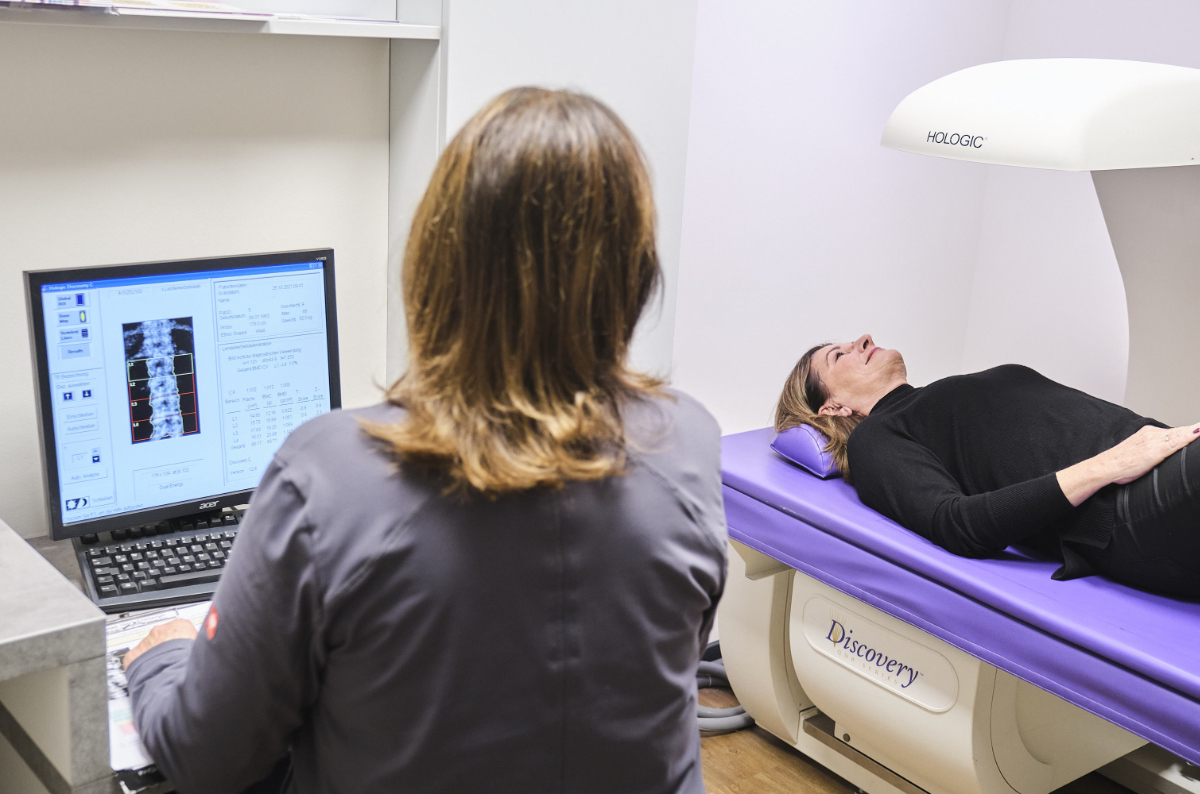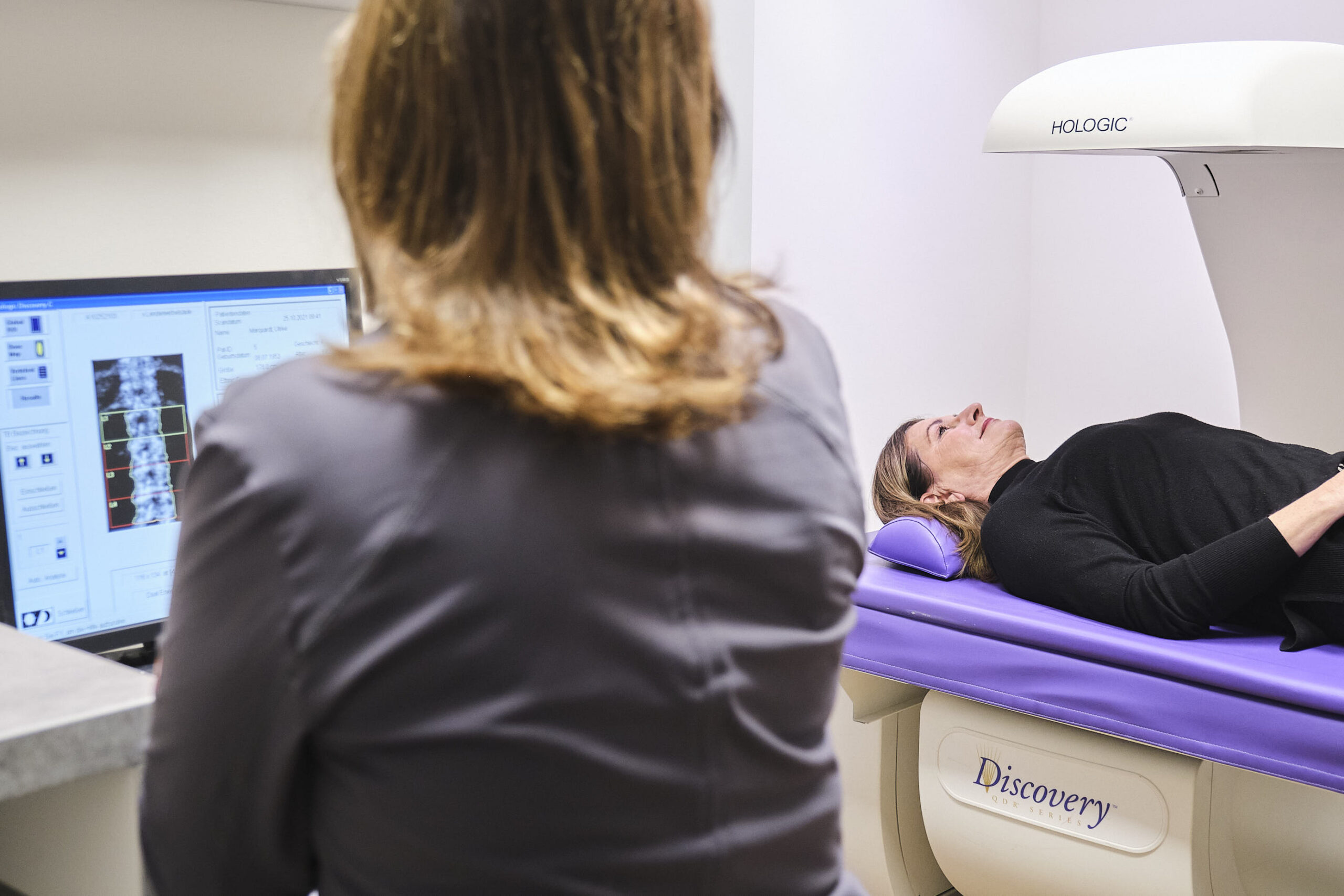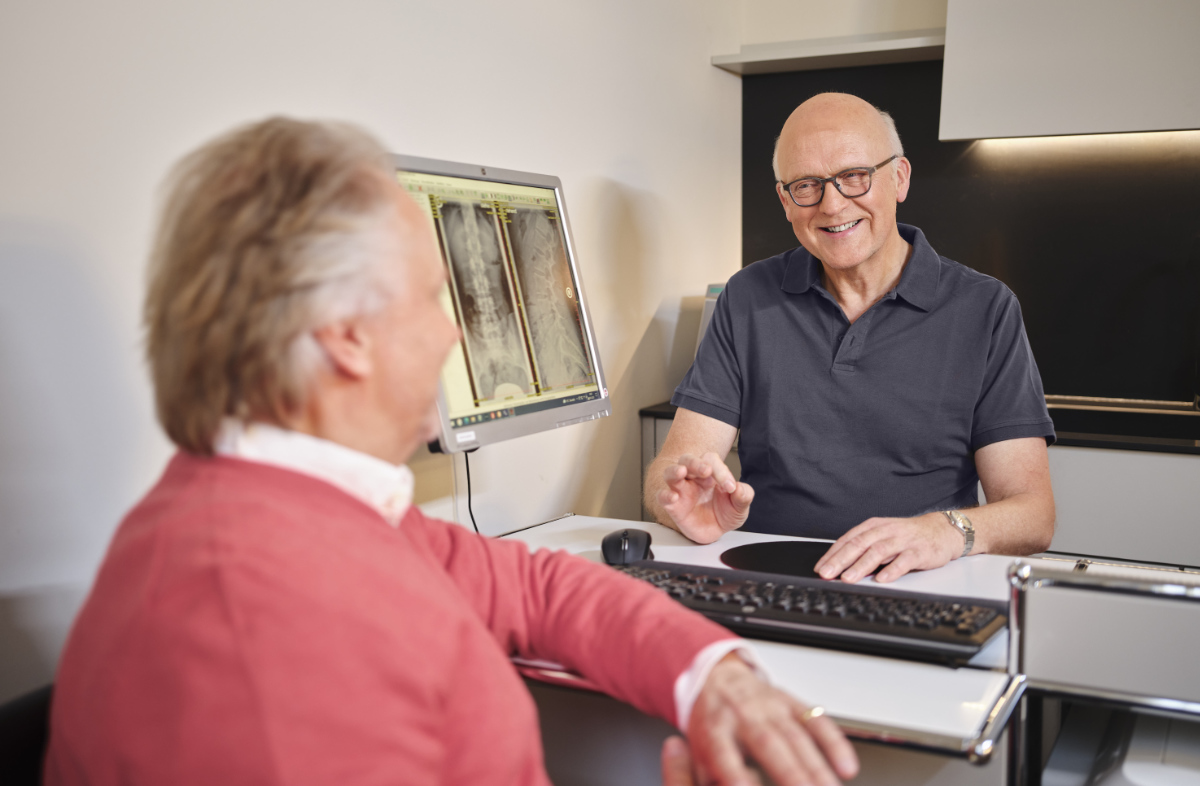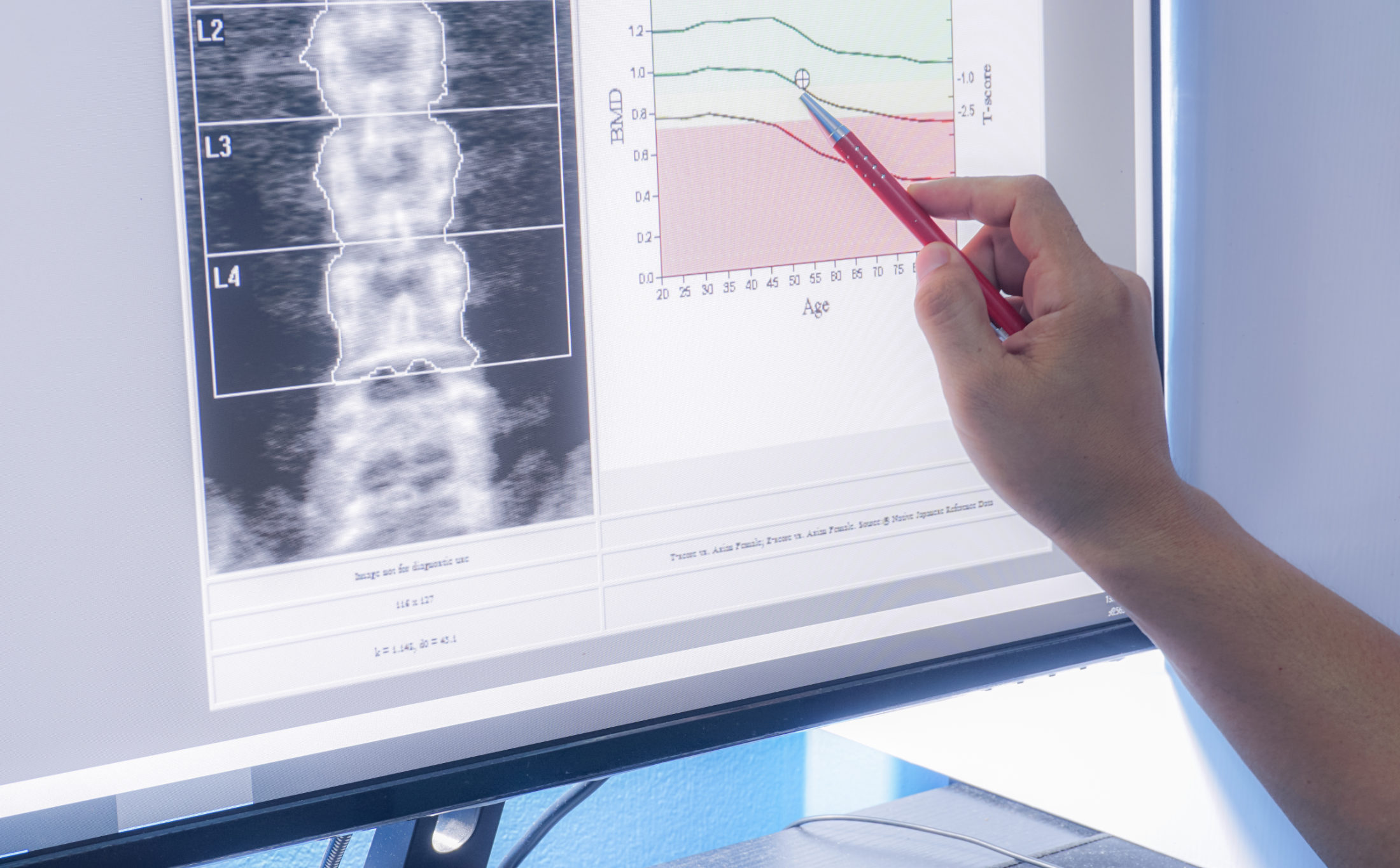Osteoporosis is one of the most common and yet greatly underestimated diseases of old age. It develops insidiously and goes unnoticed for a long time – until a fracture occurs. Osteoporosis-related fractures – especially femoral neck and vertebral body fractures – are associated with impaired quality of life and increased mortality and determine the high level of suffering of those affected. But it doesn’t have to be that way!
With modern diagnostic methods such as DXA bone density measurement, we can identify your risk at an early stage and then initiate targeted preventive measures. At the Z.O.R. – the Center for Orthopedics & Regenerative Medicine in Münster, orthopedist and osteologist Dr. Ulrich Frohberger relies on this precise, low-radiation technology to optimally protect your bone health as well. Find out in this article why early examination is so important and what advantages DXA technology offers.
Overview:

What is osteoporosis and why measure bone density?
Osteoporosis is a systemic disease characterized by a decrease in bone strength and structure. It often results in painful and serious fractures of vertebral bodies and femoral neck bones, significantly reducing quality of life and life expectancy. The causes can be genetic predispositions. However, in most cases, avoidable systemic metabolic disorders, eating habits and other lifestyle factors lead to osteoporosis. Particularly in regenerative medicine, immunological laboratory and stool examinations and, not least, genetic tests are becoming increasingly important for determining individual risk. It is becoming more and more common to initiate a causal therapy.
In Germany, an estimated 6 to 8 million people are affected by osteoporosis – women aged 50 and over and men aged 55 and over are the main focus. However, it is difficult to say exactly because the disease often goes undetected (Bone Evaluation Study 2013). Risk factors such as age, gender, numerous medications and pre-existing conditions also increase the risk of fractures, which is why we at Z.O.R – a center of excellence for osteoporosis – consider early bone density measurement to be essential and highly recommend it to our patients.
Bone density measurement – early diagnosis with DXA technology
Modern diagnostic techniques, in particular DXA technology, provide precise insights into bone health. Accurate diagnostics are a necessary prerequisite for preventive measures and individual therapy proposals, as we initiate them for you as an orthopaedic in Münster. With innovative approaches and a personal consultation approach, Dr. Frohberger offers DXA bone density measurement to provide his patients with the best possible support and to help them overcome their fear of possible fractures.

Was ist eigentlich die Knochendichte?
Dichte ist ein physikalischer Begriff und beschreibt, wie viel Masse eines Materials in einem bestimmten Volumen vorhanden ist. Die Knochendichte gibt an, wie viel mineralische Substanz sich in einer bestimmten Knochenmenge befindet. Analog zur Dichte von Wasser oder Metall lässt sich die Knochendichte als Masse pro Volumen definieren. Doch während eine höhere Dichte oft mit Stabilität gleichgesetzt wird, ist dies beim Knochen nur ein Teil der Wahrheit. Denn nicht nur die Menge an Knochensubstanz ist entscheidend, sondern auch deren Struktur.
Auf die Knochenstruktur kommt es an!
Während Wasser eine homogene Struktur besitzt, ist Knochen ein hochkomplexes, dreidimensionales Gewebe aus fein vernetzten Knochenbälkchen und Hohlräumen. Die Stabilität des Knochens hängt nicht nur von der reinen Masse ab, sondern auch davon, wie diese Struktur aufgebaut ist. Ein dichter, aber unregelmäßig angeordneter Knochen kann weniger stabil sein als ein feingliedrig strukturierter Knochen mit gleichmäßig verteilten Knochenelementen. Daher definiert sich Osteoporose nicht nur über eine verringerte Knochendichte, sondern auch über eine gestörte Mikroarchitektur des Knochens. Studien zeigen, dass insbesondere diese strukturellen Veränderungen zu einer erhöhten Brüchigkeit des Knochens führen.
Die Rolle der Knochendichtemessung
Die DXA – Knochendichtemessung dient der Überprüfung, ob eine niedrige Knochendichte vorliegt und damit die Kriterien einer Osteoporose und der belegten Wirksamkeit einer spezifischen medikamentösen Therapie erfüllt werden. Weiter dient sie der Erfassung des Ausmaßes der Knochendichteerniedrigung. Dies ist wiederum wichtig für die Abschätzung des individuellen absoluten Frakturrisikos und der damit verbundenen Empfehlungen der therapeutischen Maßnahmen.
When is basic diagnostics necessary?

Excellent diagnostics in the Z.O.R.
In order to detect osteoporosis at an early stage or to determine a possible risk, we offer a much more comprehensive, additional diagnostic examination at the Z.O.R. Münster. This includes:
- Manual full body examination
- Risk of falling analysis “osteological fall assessment”
- 3D gait analysis and muscle strength measurement
- X-rays of the spine and hip joints (if necessary)
- Laboratory tests in serum, whole blood, stool, and, if necessary, saliva and urine
DXA bone density measurement: modern, low-radiation procedure
One of the most precise methods for diagnosing osteoporosis is the DXA bone density measurement (dual-energy X-ray absorptiometry). This low-radiation X-ray procedure precisely measures the density of the bones and allows a differentiated determination of the severity of osteoporosis. This not only allows an early detection of a loss of substance, but also the success of an already initiated therapy to be monitored.
Osteoporosis is not inevitable.
If detected early, there is a lot we can do about it.
After your examination, the results of the bone density measurement, including a T-score, will be displayed. This value tells us the extent to which you have a reduction in mineral salt content and is an important factor in assessing your risk of fracture.
Depending on the test results, we will recommend holistic, integrative therapeutic approaches. These may include medication, lifestyle changes such as targeted physical activity, and dietary adjustments.
Regular monitoring of the abnormal values in the Z.O.R ensures the success of the measures taken and enables us and you to make adjustments during the course of treatment.
Preventing osteoporosis with functional medicine
At the Z.O.R., we don’t just focus on treating illnesses. We much prefer to prevent you from becoming ill in the first place. That’s why an early bone density measurement can identify risks at a very early stage, which we want to minimize together with you. The integrative, functional medicine practiced by Dr. Frohberger knows many ways to influence your risk of developing osteoporosis. Functional medicine does not consider osteoporosis as an isolated disease of the bones, but as a systemic problem influenced by various factors.
We focus on the underlying causes and individual risk factors, rather than just treating the symptoms.
Osteoporosis prevention from the Z.O.R. perspective
At Z.O.R, we view osteoporosis as a multifaceted disease that cannot be prevented by calcium supplementation alone. Instead, a systematic, personalized approach is needed that combines nutrition, gut health, hormones, stress management, and exercise.
FAQ
The cost of a DXA bone density measurement is usually between €50 and €100, depending on the scope of the examination. Private health insurance companies usually cover the costs in full, while statutory health insurance companies only cover the costs under certain conditions and to a very limited extent.
The measurement is particularly recommended for women over 50 and men over 55, as the risk of osteoporosis increases significantly in these age groups. In addition, people with known risk factors such as a family history of osteoporosis, long-term cortisone therapy or certain chronic illnesses such as rheumatism, diabetes, or disorders of the digestive system should consider an early examination.
The examination is painless and takes only a few minutes. You will lie partially undressed on an examination table while the DXA X-ray machine measures your bone density at specific points on the body – usually the hip and the lumbar spine – using a low dose of radiation.
The DXA bone density measurement is considered the gold standard in osteoporosis diagnostics. The measured values are precise and enable an accurate assessment of the individual’s risk of fracture and a follow-up.



